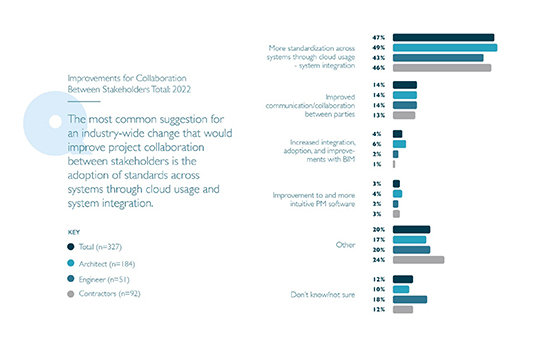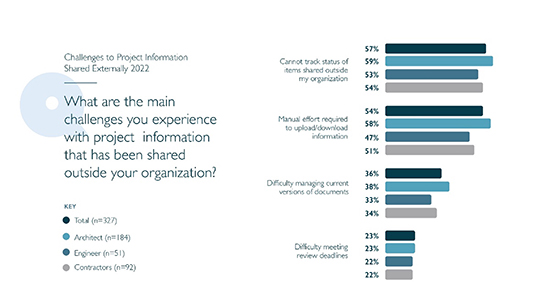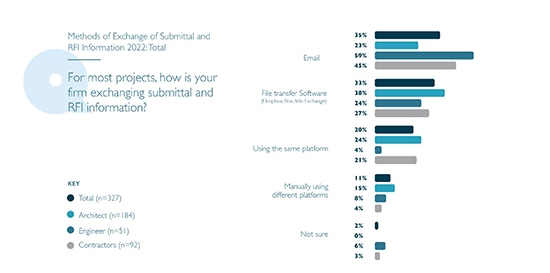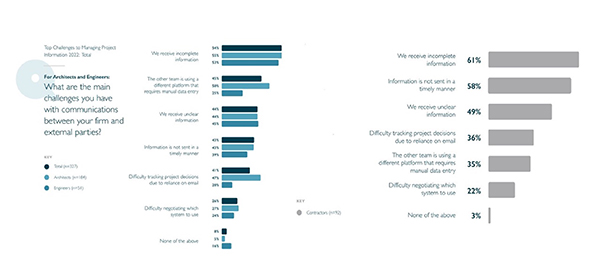
Communication, transparency and open sharing of project information are essential to building successful relationships across all stakeholders on the project team. However, the shared information must also be trusted. If incomplete, inaccurate or untimely information is sent, relationships and trust can quickly erode.
Newforma, in conjunction with the Dodge Construction Network and the Construction Progress Coalition, conducted a new study, “Finding Common Ground: The Future of Project Information Management,” to gain deeper insights into how the flow of project information impacts the architecture, engineering and construction (AEC) industry and successful project relationships.

The Paradigm Shift Needed
Survey participants were asked “What paradigm shift would do the most to improve collaboration between project stakeholders?” Responses were almost unanimous across general contractors, engineers and architects, who suggested that more standardization across systems and systems integration would be the most helpful. Responses from this open-ended question were consistent: “Interoperability of competing software so that no matter which provider firms choose to work with, they can all communicate easily,” and “If all project management software systems could communicate with each other.” See Figure 1 for more insights.
The industry is moving in the standards direction with efforts such as the International Organization for Standardization (ISO) 19650, which seeks to provide guidance regarding the processes required for effectively sharing data between all parties throughout the life cycle of the project. In many countries, such as the United Kingdom, public contracts are already subject to ISO 19650. However, the U.S. is not there yet.

Timing Is Everything
When survey participants were asked about their main challenges regarding sharing information outside their organization, more than half of all respondents (57%) said that once information was shared with external parties, they lost visibility of the project status. This lack of visibility can lead to communication issues and also impacts trust. Refer to Figure 2 for additional data.
Almost as many respondents (54%) struggle with the manual effort required to upload and download information between systems. Human error and delays in communication can be introduced when workflow processes are inconsistent and different platforms used by external teams involve the manual upload and download of information.
This year’s survey also revealed that email is a primary communication vehicle between external parties for sending and receiving submittals and requests for information (RFIs). If the email is not forwarded in a timely manner, or team members are out of the office, days could be lost in the review process. Given that submittals and RFIs usually have contractual response times, a few days can have a major impact on the project. Software solutions for managing email can alleviate some of these problems. An automated system for filing emails to the project enables all project team members to access important emails regardless of who the email was initially sent to. Figure 3 shares more information.

Improving Accuracy & Consistency
Another factor that impacts building trusted relationships is the accuracy and completeness of the information being shared. Over half the architects and engineers say one of the main challenges with communication between firms is receiving incomplete information. Almost as many also state the information received is unclear or is not received in a timely manner. More contractors (61%) cited receiving incomplete information as a major challenge. In addition, information not sent in a timely manner ranked almost as high.
During the construction administration phase of a project, submittals can be rejected or RFI responses can be delayed due to incomplete information. Many construction administration workflows require several manual administrative tasks to move data from one system to another. For example, when submittals and RFIs are transferred via email, an administrator must download the information from their system and reenter it in the email. This introduces a level of inconsistency as individuals are making decisions about what information to include. Once the email is received, this information must then be manually extracted from the email and entered into the design team’s system of record. These manual processes introduce a host of delays and human error.
During the construction phase, effective communication of project decisions is essential to building trust across the team. If information is incomplete, inaccurate or not received in a timely manner, mistakes will be made (see Figure 4). Mistakes often result in rework, schedule delays and increased costs. The bottom line is that it impacts all parties’ profitability.

Technology in Relationships
An automated approach for transferring data between systems provides the guardrails necessary to ensure data sent between parties is accurate and complete. Automation of workflows also provides standardization of processes in support of efforts such as ISO 19650. Today, interoperability between systems is accomplished through standard application programming interfaces (APIs). The required information to be transferred between systems is mapped through the API to ensure information is complete and accurate. However, the industry continues to struggle with software integration and interoperability issues. Some suggest that having everyone on the same platform using the same set of tools will resolve issues, but it may not be practical. Integration of applications does not necessarily require all project stakeholders to use the same centralized system. Stakeholders prefer to use the platforms and tools that best suit their needs.
ISO 19650 defines a common data environment (CDE) which is considered the “single source of information used to collect, manage and disseminate documentation, the graphical model and nongraphical data for the whole project team.” There is often confusion around the meaning or intent of “single source of information.” Although technically this could be accomplished in one physical environment, ISO 19650 3.3.15 states “information exchange involves the sharing and coordination of information through a CDE, using open standards whenever possible and clearly defined operating procedures.” In effect, a CDE can be considered as a digital hub where several different environments are connected through APIs using open standards.
Architectural firm BWBR was able to streamline its construction administration with contractors using a construction management software platform. By implementing a project information management (PIM) connector, the contractor was able to work in their preferred environment while BWBR continued using its PIM software. The connector, built on standard APIs, automated the transfer of submittal and RFI information between systems. This made collaboration easy building trust and strengthened the team relationship between BWBR and the contractor.
Integrated software solutions can provide standardization and consistency in how information is shared. It can also eliminate manual data entry processes that are prone to errors and delays. Technology can play a major role in improving the quality and timeliness of shared information, and in turn, can build trusted relationships across project stakeholders.
